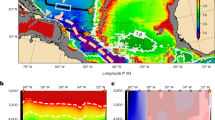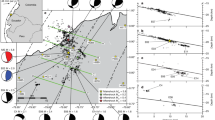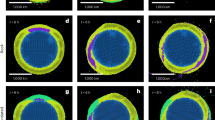Abstract
Where continental plates break apart, slip along multiple normal faults provides the required space for the Earth's crust to thin and subside1. After initial rifting, however, the displacement on normal faults observed at the sea floor seems not to match the inferred extension2. Here we show that crustal thinning can be accomplished in such extensional environments by a system of conjugate concave downward faults instead of multiple normal faults. Our model predicts that these concave faults accumulate large amounts of extension and form a very thin crust (< 10 km) by exhumation of mid-crustal and mantle material. This transitional crust is capped by sub-horizontal detachment surfaces over distances exceeding 100 km with little visible deformation. Our rift model is based on numerical experiments constrained by geological and geophysical observations from the Alpine Tethys and Iberia/Newfoundland margins3,4,5,6,7,8,9. Furthermore, we suggest that the observed transition from broadly distributed and symmetric extension to localized and asymmetric rifting is directly controlled by the existence of a strong gabbroic lower crust. The presence of such lower crustal gabbros is well constrained for the Alpine Tethys system4,9. Initial decoupling of upper crustal deformation from lower crustal and mantle deformation by progressive weakening of the middle crust is an essential requirement to reproduce the observed rift evolution. This is achieved in our models by the formation of weak ductile shear zones.
This is a preview of subscription content, access via your institution
Access options
Subscribe to this journal
Receive 51 print issues and online access
$199.00 per year
only $3.90 per issue
Buy this article
- Purchase on Springer Link
- Instant access to full article PDF
Prices may be subject to local taxes which are calculated during checkout



Similar content being viewed by others
References
Vening-Meisnez, F. A. Les grabens Africains résultants de compression ou de tension de la croûte terrestre? Mém. Inst. R. Colon. Belge 21, 539–552 (1950)
Karner, G. D., Driscoll, N. W. & Barker, D. H. N. in Petroleum Systems and Evolving Technologies in African Exploration and Production (eds Arthur, T., MacGregor, D. & Cameron, N. R.). Spec. Publ. Geol. Soc. Lond. 207, 105–129 (2003).
Whitmarsh, R. B., Manatschal, G. & Minshull, T. A. Evolution of magma-poor continental margins from rifting to sea-floor spreading. Nature 413, 150–154 (2001)
Manatschal, G. New models for evolution of magma-poor rifted margins based on a review of data and concepts from West Iberia and the Alps. Int. J. Earth Sci. 93, 432–466 (2004)
Decandia, F. A. & La Elter, P. “Zona” ofiolitifera del Bracco nel settore compreso fra Levanto e la Val Graveglia (Appennino ligure). Mem. Soc. Geol. Ital. 11, 503–530 (1972)
Boillot, G. et al. Tectonic denudation of the upper mantle along passive margins: A model based on drilling results (ODP Leg 103, western Galicia margin, Spain). Tectonophysics 132, 335–342 (1987)
Froitzheim, N. & Eberli, G. P. Extensional detachment faulting in the evolution of a Tethys passive continental margin, eastern Alps, Switzerland. Geol. Soc. Am. Bull. 102, 1297–1308 (1990)
Reston, T. J., Krawczyk, C. M. & Hoffmann, H. J. in The Tectonics, Sedimentation and Palaeoceanography of the North Atlantic Region (eds Scrutton, R. A., Stoker, M. S., Shimmield, G. B. & Tudhope, A. W.) Geol. Soc. Spec. Publ. 90, 93–109 (1995).
Müntener, O., Hermann, J. & Trommsdorff, V. Cooling history and exhumation of lower-crustal granulite and upper mantle (Malenco, eastern central Alps). J. Petrol. 41, 175–200 (2000)
Huismans, R. & Beaumont, C. H. Symmetric and asymmetric lithospheric extension; relative effects of frictional-plastic and viscous strain softening. J. Geophys. Res. 108, 10.1029/2002JB002026 (2003)
Handy, M. R. Deformation regimes and the rheological evolution of fault zones in the lithosphere: the effects of pressure, temperature, grain size and time. Tectonophysics 163, 119–152 (1989)
Bertotti, G. Early Mesozoic extension and Alpine shortening in the western Southern Alps: The geology of the area between Lugano and Menaggio (Lombardy, northern Italy). Mem. Sci. Geol. (Padova) 43, 17–123 (1991)
Rutter, E. H., Brodie, K. H. & Evans, P. J. in The Geometry of Naturally Deformed Rocks (eds Casey, M., Dietrich, D., Ford, M., Watkinson, J. & Hudleston, P. J.) J. Struct. Geol. 15, 647–662 (1993).
Hirth, G. & Tullis, J. Dislocation creep regimes in quartz aggregates. J. Struct. Geol. 14, 145–159 (1992)
Rutter, E. H. & Brodie, K. H. in Continental Lower Crust (eds Fountain, D. M., Arculus, R. J. & Kay, R. W.) 201–267 (Elsevier, New York, 1992)
Fricke, H. C., Wickham, S. M. & O'Neil, J. R. Oxygen and hydrogen isotope evidence for meteoric water infiltration during mylonitization and uplift in the Ruby Montains-East Humboldt Range core complex, Nevada. Contrib. Mineral. Petrol. 111, 203–221 (1992)
White, S. H., Burrows, S. E., Carreras, J., Shaw, N. D. & Humphreys, F. J. On mylonites in ductile shear zones. J. Struct. Geol. 2, 175–187 (1980)
Jordan, P. The rheology of polymineralic rocks—an approach. Geol. Rundsch. 77, 285–294 (1988)
Gilbert, L. E., Scholz, C. H. & Beavan, J. Strain localization along the San Andreas Fault; consequences for loading mechanisms. J. Geophys. Res. 99, 23975–23984 (1994)
Tankard, A. J., Welsink, H. J. & Jenkins, W. A. M. in Extensional Tectonics and Stratigraphy of the North Atlantic Margins (eds Tankard, A. J. & Balkwill, H. R.) Am. Assoc. Petroleum Geol. Mem. 46, 265–282 (1989).
Handy, M. R. & Zingg, A. The tectonic and rheological evolution of an attenuated cross section of the continental crust: Ivrea crustal section, southern Alps, northwestern Italy and southern Switzerland. Geol. Soc. Am. Bull. 103, 236–253 (1991)
Pérez-Gussinyé, M., Ranero, C. R., Reston, T. J. & Sawyer, D. Mechanisms of extension at non-volcanic margins: Evidence from the Galicia interior basin, west of Iberia. J. Geophys. Res. 108, 10.1029/2001JB000901 (2003)
Contrucci, I. et al. Deep structure of the West African continental margin (Congo, Zaïre, Angola), between 5°S and 8°S, from reflection/refraction seismics and gravity data. Geophys. J. Int. 158, 529–553 (2004)
Ingebritsen, S. E. & Manning, C. E. Geological implications of a permeability-depth curve for the continental crust. Geology 27, 1107–1110 (1999)
Poliakov, A. N. B., Podladchikov, Y. & Talbot, C. Initiation of salt diapirs with frictional overburdens—numerical experiments. Tectonophysics 228, 199–210 (1993)
Taylor, B., Goodliffe, A. M. & Martinez, M. How continents break up: Insights from Papua New Guinea. J. Geophys. Res. 104, 7497–7512 (1999)
McNutt, M. K., Diament, M. & Kogan, M. G. Variations of elastic plate thickness at continental thrust belts. J. Geophys. Res. 93, 8825–8838 (1988)
Lavier, L. L. & Buck, W. R. Half-graben vs. large-offset low-angle normal fault: The importance of keeping cool during normal faulting. J. Geophys. Res. 107, doi:10.1029/2001JB000513 (2002)
Escartín, J., Hirth, G. & Evans, B. Effects of serpentinization on the lithospheric strength and the style of normal faulting at slow-spreading ridges. Earth Planet. Sci. Lett. 151, 181–190 (1997)
Brace, W. F. & Kohlstedt, D. L. Limit on lithospheric stress imposed by laboratory experiments. J. Geophys. Res. 85, 6248–6252 (1995)
Shelton, G. & Tullis, J. A. Experimental flow laws for crustal rocks. Trans. Am. Geophys. Union 62, 396 (1981)
Goetze, C. The mechanisms of creep in olivine. Phil. Trans. R. Soc. Lond. 288, 99–119 (1978)
Braun, J. & Beaumont, C. in Sedimentary Basins and Basin-Forming Mechanisms (eds Beaumont, C. & Tankard, A.) Can. Soc. Petrol. Geol. Mem. 12, 241–258 (1987).
Acknowledgements
We thank O. Müntener, G. Péron-Pinvidic, H. Van Avendonk, W. Powell and N. Bangs for help with preparation of the manuscript. We thank T. J. Reston for comments on the manuscript. G.M. was funded by a grant from the programme ‘GDR Marge’. L.L.L. was supported by a grant from ExxonMobil Upstream Research Company.
Author information
Authors and Affiliations
Corresponding author
Ethics declarations
Competing interests
Reprints and permissions information is available at npg.nature.com/reprintsandpermissions. The authors declare no competing financial interests.
Rights and permissions
About this article
Cite this article
Lavier, L., Manatschal, G. A mechanism to thin the continental lithosphere at magma-poor margins. Nature 440, 324–328 (2006). https://doi.org/10.1038/nature04608
Received:
Accepted:
Published:
Issue Date:
DOI: https://doi.org/10.1038/nature04608
This article is cited by
-
Complete transition from mantle plume to mantle exhumation on the Central Atlantic Guyana/Suriname margin
Communications Earth & Environment (2024)
-
Linking mineral deposits to crustal necking: insights from the Western Alps
Mineralium Deposita (2024)
-
Towards a process-based understanding of rifted continental margins
Nature Reviews Earth & Environment (2023)
-
Rift domains and structural framework of the northwestern Red Sea basin, Egypt
International Journal of Earth Sciences (2023)
-
The seismic reflection Moho across the mid-Norwegian continental rifted margin
Communications Earth & Environment (2022)
Comments
By submitting a comment you agree to abide by our Terms and Community Guidelines. If you find something abusive or that does not comply with our terms or guidelines please flag it as inappropriate.



